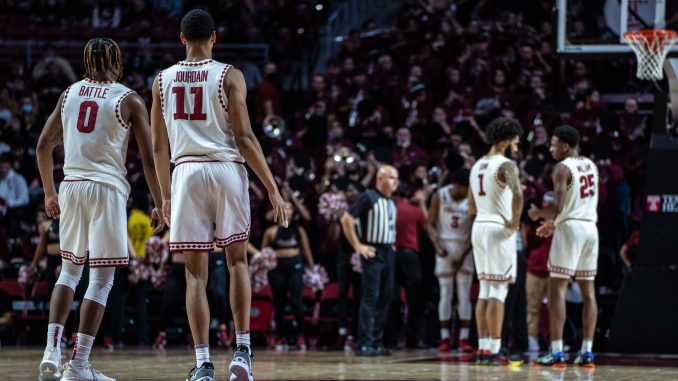
Six games into the 2021-22 season, Temple University men’s basketball (3-3, 0-0 The American Athletic Conference) has looked impressive in some areas and lackluster in others.
The Owls have out-rebounded teams by an average of about six rebounds a game, even though they often utilize three guards on the floor. They also lead their opponents in steals and blocks per game.
But their 3-point shooting percentage and free-throw percentage can both be improved on, and they need to find reliable shooters before conference play begins.
Here are some takeaways from the team’s first six games of the season.
Secondary scoring
Sophomore guard Khalif Battle is averaging 21.3 points per game on 53.8 percent shooting in 32.3 minutes per game. Battle and redshirt-freshman guard Damian Dunn, who is averaging 10.3 points per game, are the only two players averaging double-digit points per game.
When Battle gets more defensive attention, the Owls don’t have a reliable second or third option to lean on.
Off the bench, redshirt-sophomore guard Tai Strickland looks like he can shoot off the dribble, but he only plays an average of 17.8 minutes per game.
Temple lost 76-71 in a close game to the University of Southern California (6-0, 0-0 The PAC-12 Conference) on Nov. 13.
The Owls were defeated because they failed to find a true shot-creator besides Battle, who scored 26 points. While the Owls relied on several players for points, including freshman forward Zach Hicks, no true threat complemented Temple’s lead guard. Temple’s next highest scorer, Strickland, scored only nine points.
Once the Owls find a secondary scorer, they can threaten teams in a variety of ways across the floor, adding to their 67.2 points per game average, good for only ninth in the AAC.
Free throw inconsistency
The Owls’ free throw shooting is mediocre so far, except for Dunn, who is shooting 90.5 percent from the free throw line.
Temple struggled at the free throw line last season, too, as they made just 71.6 percent of their attempts.
This year’s team is averaging 69.7 percent, yet their best free throw shooting has come in bunches.
Against the Trojans, Battle missed three key free throws down the stretch.
“We lost the game at the free throw line,” Battle said after the USC game. “I can take responsibility for that.”
Freshman guard Jeremiah Williams has made 16 of 27 free throws this season, but went 13 of 14 against Elon University (2-5, 0-0 The Colonial Athletic Association) on Nov. 21. The Owls made 24 of their 29 total free throw attempts in the game.
Free throw shooting is an integral part of every practice for the Owls, but it has not translated to their performance in games. Temple’s free throw shooting, if improved, will drastically boost their chances of winning.
Nick Jourdain’s emergence
So far this season, freshman forward Nick Jourdain leads the team in steals, blocks and rebounding.
This is an unexpected feat — especially with junior forward Jake Forrester in the starting lineup — but Jourdain has filled the role of defensive-specialist so far this year.
“I try to show, block shots,” Jourdain said. “[Forrester], [Emmanuel Okpomo], [Sage Tolbert], they push me with their toughness every single day.”
Jourdain is the team’s primary rim protector, despite only averaging 3.2 points in 19.2 minutes per game. He’s shifting well on defense and crashing the offensive glass. The six-foot-eight forward brings solid positional awareness and an innate tracking of the ball inside the paint on defense.
“He moves pretty good out there on the floor,” said head coach Aaron McKie. “[Jourdain] has been huge for us on the defensive side.”
Against Clemson University (5-2, 0-0 The Atlantic Coast Conference) on Nov. 18, Jourdain recorded five blocks — more than any other Owl this season.
With his quick movements and workhorse attitude on both sides of the ball, Jourdain’s abilities complement the team’s other big men. He will be a plug-and-play option for McKie as his minutes increase this season.
First half faults
The Owls have headed into halftime trailing in five out of their six games so far this season.
Temple’s only lead entering halftime was by one point against the University of Maryland Eastern Shore (2-4, 0-0 The Mid-Eastern Atlantic Conference) on Nov. 10.
Their first half shot selection has led to easy rebounds for their opponents, giving them time to set up their halfcourt offense. The Owls, meanwhile, are rushing shots early in possessions, or finding bad looks later in possessions.
In their first two games, the Owls shot 35.89 percent from the field in the first half, and 50.4 percent from the field in the second half. This helped them pull away from UMES and keep the game close against the Trojans.
If the Owls had gotten out ahead in games and avoided insurmountable deficits, their second half performances would have kept them in most of the games they’ve played.
The Owls were defeated in two games by at least 20 points. They battled back from a 19-point deficit against the Trojans, only losing by five.
Against Elon and Delaware, the Owls won after overcoming deficits of more than 10 points. They’ve found ways to keep some games close or pull ahead, but still find themselves down heavily in others.
The Owls have 26 games left to prove their worth, and if they can get better in several areas, they could be true competitors in the American.


Be the first to comment